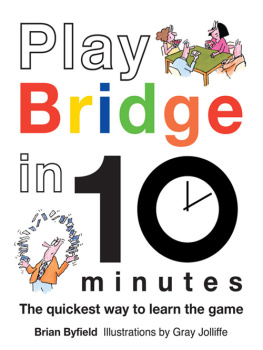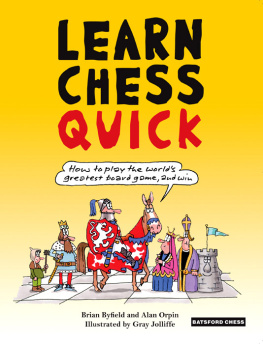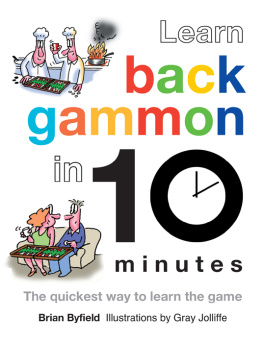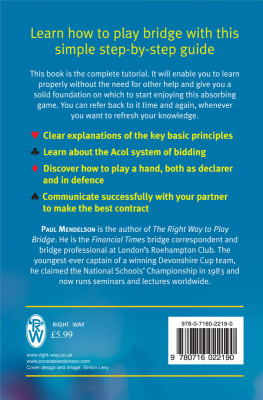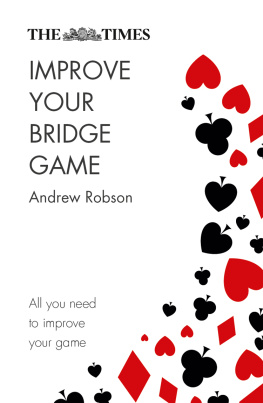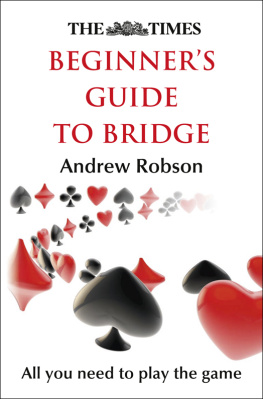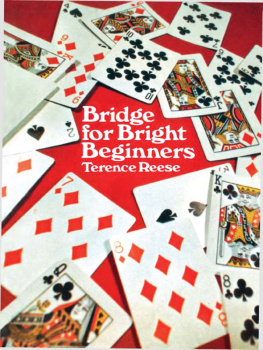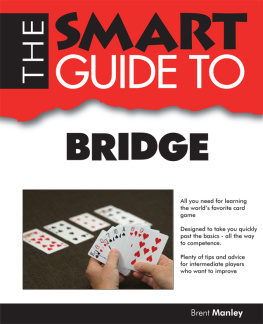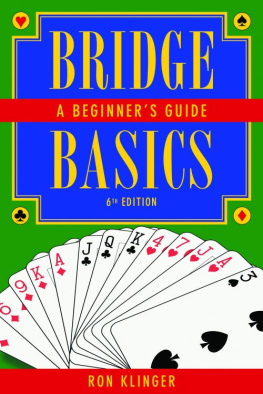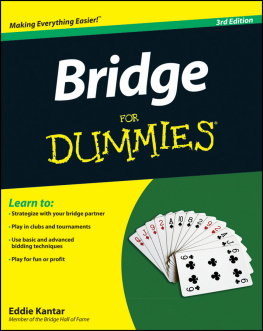
First hardback publication in the United Kingdom in 2011 by
Batsford, 10 Southcombe Street, London W14 0RA
An imprint of Anova Books Company Ltd
Copyright Batsford 2011
Text copyright Brian Byfield 2011
Cartoons copyright Gray Jolliffe 2011
Playing card illustrations copyright Catherine Byfield 2011
The moral right of Brian Byfield to be identified as the author of this work has been asserted in accordance with the Copyright, Designs and Patents Act 1988. All rights reserved. No part of this publication may be reproduced, stored in a retrieval system, or transmitted in any form or by any means, electronic, mechanical, photocopying, recording or otherwise, without the prior written permission of the copyright owner.
First eBook publication 2012
eBook ISBN 978-1-84994-087-0
Also available in hardback
Hardback ISBN 978-1-84994-016-0


Got any plans for the next ten minutes?
Since its introduction in the 1920s, Bridge has become one of the most popular card games in the world. Its a game for four players, two playing against two.
Playing Bridge is a chance to socialise, use your brain and enjoy a card game that can be equally rewarding whether winning or losing. Although Bridge is complex, the basic rules are quite easy to learn. So lets get started.
Bridge is played with two packs of 52 cards. Two packs are used so that one can be shuffled while the other is being dealt. Open a pack now. It will be useful as you read the book.


The pack is spread face down on the table and each player takes a card. The two who draw the highest cards play together against the other two. Partners sit opposite each other. Sometimes husbands, wives and lovers are persuaded not to play together, in case of bickering. Bridge is a game in which egos are easily bruised and, as with driving lessons, couples often make poor partners. So, at the table you should have two opponents and one friend.

Right - cards, card table -Are you with me so far?
The player with the highest card deals first, starting with the player to his left. All 52 cards are dealt, each player receiving one card at a time. After the cards have been dealt, the players pick up their cards.

They will have 13 each.
Sorting out your hand
First, sort out your cards. All the Spades together, then the Hearts, Clubs and Diamonds. Now theyll be arranged so theyre black, red, black, red, which makes them easier to see and helps you to avoid mistakes.
Then place them so each suit ranks from high to low.

The cards rank from the Ace down to the Two.
Ace, King, Queen and Jack are called Honour Cards. Sometimes the Ten is considered an Honour Card when its accompanied by the Jack. Spades, Hearts, Diamonds and Clubs are the suits, and rank down in that order. Spades and Hearts are called major suits; Diamonds and Clubs are minor suits.

Judging your hand
You do this by counting your points. Heres how it works:
| Jack | 1 point |
| Queen | 2 points |
| King | 3 points |
| Ace | 4 points |
If your hand looks like this, how many points do you have?

The answer is 10 points, an average hand.
As each pack amounts to 40 points, youll need at least 12 points to make an opening bid. Each pair bids against the other to win the contract. Just like at Sothebys, the prize goes to the highest bidder.

Shame he cant play Bridge like he shuffles.
Bidding
The two partnerships bid against each other to decide who will make the contract, which suit will be Trumps, or whether there will be no Trumps. No Trumps is a higher bid than a suit bid.
Trumps
A suit that has been chosen as the master suit is called the Trump suit. If a suit has been led in which you hold no cards, you may use a card from the Trump suit to trump the trick. Trick: four cards, one from each player. The player who plays the higher card wins the trick. If another player does not play a higher Trump card, the trick is yours.
No Trumps
If no master suit has been chosen, all suits are equal.
The dealer always bids first, and bidding then continues round the table clockwise. Each bid must contract to make a greater number of tricks than the previous bid or the same number of tricks in a higher suit. If a player chooses not to bid he says no bid. If none of the players makes a bid, the hands are thrown in and the cards are re-dealt. The lowest bid is one, a contract to win seven tricks. The highest bid is seven, a contract to win all 13 tricks.


Hes up to his tricks again.
How bidding works
The dealer always bids first, and bidding continues round the table clockwise. The lowest possible bid is 1 Club (a contract to make seven tricks with Clubs as trumps). Then 1 Diamond, 1 Heart, 1 Spade, 1 No Trump, and so on. So the bid above 1 No Trump is 2 Clubs, and so on. A player can only bid a greater number of tricks than the previous bid, or an equal number of tricks in a higher suit or No Trumps.
Bidding is a way of talking to your partner and giving information about your hand. When a player bids he is trying to tell his partner how many tricks, in excess of six, he expects to win. He is also trying to tell him which suit is his strongest, or whether he has a balanced hand.
When a player responds to his partners bid, he is trying to give him some idea about the shape and strength of his own hand, and whether he can support his chosen suit or give him strength in another suit. Having five or more cards in a suit is a huge advantage. Length is strength.

